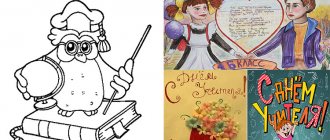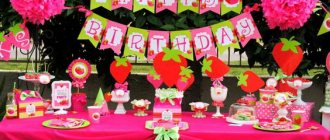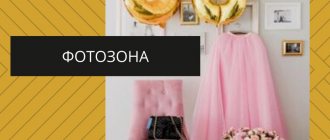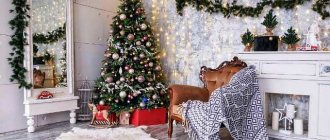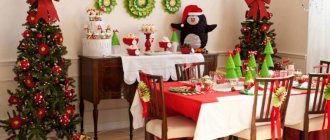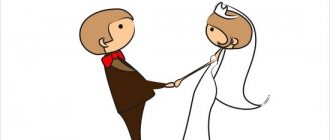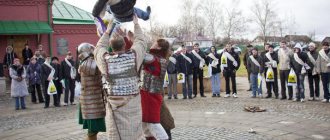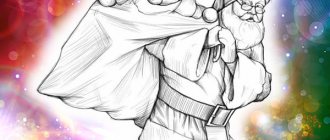What is needed to design a wall newspaper
A wall newspaper will attract more attention if it is bright and colorful. For decoration, you can choose any materials, even what you have at hand: fabric, cotton wool, colored paper, foil, fur, etc. The classic basis is whatman paper in A1 format.
A wall newspaper for schoolchildren or kindergarten children contains comic New Year's greetings, images of fairy-tale characters, drawings, and photo collages.
A coloring newspaper is a ready-made layout that can be decorated by the whole family. You need to download special templates and print them in a specialized salon. Printing services on Whatman paper and larger formats are no longer a novelty.
The application is suitable for people who cannot or do not want to draw. It can be made from colored paper, magazine clippings, postcards, photographs, pieces of fabric, ribbons and even optical discs.
3D technology includes volumetric design. These can be different types of handicrafts: scrapbooking, quilling, origami. You can also use small Christmas tree decorations, pebbles, branches, buttons and other materials.
A standard set of tools and materials includes: scissors, glue, ruler, colored pencils, felt-tip pens, paints.
Design of the first and last pages
It is not for nothing that the first page of a newspaper issue is called its showcase, since it should give readers an idea of its content. The layout and design of the front page have a number of features related to the fact that the most timely and most important messages, official documents and similar materials are placed here (Fig. 1). It should also be taken into account that its usable area is smaller than that of the rest of the pages of the issue, since the headline part of the newspaper is located here.
Rice. 1. Front page of the Izvestia newspaper
When planning the first page of an issue, they first of all solve issues related to the layout and design of the editorial. The editorial (“issue flag”) should attract the reader’s attention and be read. It is placed “at the opening” of the page - immediately below the name of the newspaper. For additional emphasis, the title of the editorial is typed in a bright, large, clear font. It is better to type the text of the editorial in a larger font than the rest of the page. However, the decision to type editorials in bold fonts (bold or italic) can hardly be considered successful: such text is difficult to read. In some newspapers, the editorial is typed in a wide format, sometimes at the same time framing it with rulers, which makes it look beautiful and stand out well on the page.
An editorial is one of the elements that forms the face of a newspaper, therefore, having chosen any version of its layout and design, you should stick to it in the future, without trying to change the design from issue to issue.
An important element of the first page is the so-called spiegel - an area on the side of the headline part of the newspaper, above the initial columns of the page. In the spiegel you can place a current photograph that illustrates the main theme of the issue, a slogan, a call. This is where they sometimes start an important article or collection. Spiegel is one of the most prominent places on the first page, so it is inappropriate to occupy it with secondary material.
Moving the header part from its usual place to the right opens up additional possibilities for the layout and design of the first page. This allows you to open it with an editorial, an important official announcement, or other material that is pushed to the top.
On the first page you can inform readers about the contents of the issue, for which a bright “poster” is often used. Messages about the most important materials, indicating the pages on which they are printed, are typed in large fonts, grouped in one common frame or in several frames and installed in the spiel or in another prominent place on the strip (Fig. 2).
Rice. 2. Front page of the newspaper "Rakurs"
If an important interview, interesting thematic selection, or other highlight of the issue is published on any of the other pages of the issue, it is recommended to specifically report this on the first page with an indication (in editorial offices it is sometimes called a “whistle”) where to look for this material. Often such a link includes an explanation of the reason and purpose of publication of the material.
The first page requires bright, eye-catching illustrations (Fig. 3). You can install just one illustration here, but it should immediately attract the attention of readers and decorate the entire page. Large close-up posters, montages, reportage photographs, photographic portraits, cartoons, and caricatures look good, but, for example, a photographic landscape would be out of place. The page is decorated with an illustration placed “at the opening” of the issue if the newspaper title is moved to the right. The design practice of many newspapers has included the technique of inserting a photo illustration or caricature into an editorial. Such an illustration enhances the impact of the editorial and decorates the page.
Rice. 3. A brightly illustrated front page of the Virginian-Pilot newspaper with a strong emphasis on the editorial.
The last page of the newspaper also has its own layout and design features. Many publications place small information materials, anecdotes, and advertising blocks here, so they prefer to type it up on a larger number of columns (Fig. 4). On this page, broken layout techniques are used more often and more actively, trying to diversify and enliven the presentation of materials.
Rice. 4. Layout of the last page of the Izvestia newspaper
The last page also features more varied illustrations. Some of the newspaper illustrations are used only on this page. The usable area of the last page of the issue is somewhat smaller than the area of the inner stripes, since the output information is printed on it.
Bright headlines are the key to the success of a New Year's poster
To make your wall newspaper look colorful and catchy, you need to decorate the headings. They can be hand-drawn or three-dimensional. To do this you will need PVA glue and corrugated paper:
- Draw the outline of the title.
- We cut into strips and twist the corrugated paper into separate flagella.
- Apply glue to the letters and fill the central part with flagella. We also carefully coat the top of the rolls with glue.
Also, a three-dimensional inscription can be made from cotton wool. Paint the letters with watercolors, cover them with PVA glue and sprinkle with glitter.
Poster page
A poster page is a type of topic page. In the USSR, poster pages first appeared in the newspaper “Rural Life” and then became widespread in many local newspapers. Today, this type of thematic page is extremely rare.
The constant elements of the poster page composition are a header, an introduction explaining the purpose of the publication, the main material, often broken into parts, and sometimes an editorial conclusion.
Usually, only one or two articles are placed on the poster page: a large speech or a detailed story, to which sometimes a commentary from a specialist is attached.
The poster page can be hung on the wall, so its text is typed in large font on a wide format. This page is most often laid out in three or four wide columns. The main provisions are highlighted in the text in bold or italics.
The poster page should attract attention with a lively design - a large, catchy header, bright illustrations. Here you can use different types of illustrations: photographs or hand-drawn portraits, reportage photographs, diagrams, drawings, diagrams and even caricatures. It is recommended to break up the continuous text of the page with subheadings, illustrations, “poster” frames in which digital data, slogans, etc. are installed.
The second color provides additional options for designing the poster page. It is successfully used to highlight the header, the most important headings, “posters”, etc.
In many newspapers, the poster page is built according to one established scheme: after the header, in the upper left or right corner of the page, a photograph or reportage photograph is placed, below - an introduction in a frame, then - the continuous text of the speech. At one time, dozens of such pages of posters, as similar to each other as two drops of water, appeared in a variety of publications.
A spread can also be designed as a poster, especially in small format publications. The editors of regional newspapers often publish similar double-page posters during election campaigns.
Stencil poster for New Year
The basis of the idea is the use of templates and patterns. You can prepare such a poster alone. To make a wall newspaper you will need:
- A1 sheet;
- white, blue and black gouache;
- printed templates;
- scissors;
- pencil;
- ruler;
- PVA glue;
- brush.
This is the simplest five-minute poster. The only thing you will have to spend time on is printing and cutting out templates and congratulations:
- We prepare the materials, print and cut out the blanks.
- We mark on whatman paper with a pencil the area under the inscription: “Happy New Year!”
- Paint the sheet with blue paint. To prevent it from curling, we press down on the edges with any heavy objects.
- We place the blanks on the poster to see the approximate final result.
- We draw a congratulatory inscription along the pencil line in white and shade it with black.
- We glue all the templates and wait until the wall newspaper dries.
The poster may seem pale, but if desired, individual details can be decorated with brighter colors.
Thematic page
The feature page is one of the oldest forms of reporting in a newspaper. Essentially, this is a thematic selection that occupies the entire page and is dedicated to an important topic or event: an anniversary, important events, etc. Thematic pages are very diverse in their nature and goals, they also differ in the presentation of material. Sometimes only one material is placed on such a page - a large journalistic or analytical article, report, etc. By using various techniques for presenting large material in a newspaper, you can make such a page easier to perceive. It is recommended to break this page into meaningful parts with a subtitle above each, use a drawn header, various illustrations (photographs, drawings, screensavers) to enliven them, insert framed quotes into the text, etc.
More often, a composite thematic page is found - from several materials devoted to one topic, but revealing it from different sides. The main task when laying out such a page is to make the presentation of material varied. The design of a thematic page, like a collection, depends, of course, on the role and significance of its materials: some report facts, others comment on these facts, analyze them, others generalize them, draw conclusions from them, etc. The basis of the thematic page should be journalistic material - an article, an essay, and, in extreme cases, an extended introduction or other speech that plays the role of an editorial for the entire page and summarizes what the rest of its materials are about. Around this journalistic core are located the rest, including small ones: notes, messages, etc.
If an introduction is placed on a topic page, it is highlighted either in a non-standard font, which should be one to two points larger than the usual text font, or in a non-standard format, rulers or border. The intro, as a rule, is installed at the top, at the beginning of the page, and sometimes even at the same level as the header, which seems to cover all the materials on the thematic page. The header is typed in a large, bright font: 60 or even 72 pt on an A2 page or 3648 pt on an A3 page. Many different techniques are used to design a header on a thematic page. Sometimes it is derived from the input placed “at the opening” of the strip. A hat paired with an illustration, such as a photograph, looks beautiful. A well-executed hand-drawn header adorns the entire page.
An illustration on a thematic page helps to reveal the chosen topic, and also serves to thin out the text, especially if there is only one large material on the page. A thematic page skillfully illustrated with photographs and drawings is easier for readers to perceive.
The thematic page is mostly laid out asymmetrically, which allows you to dynamically arrange the materials and better highlight the most important ones. But symmetrical layout is also possible, for example, if the page is dedicated to an anniversary.
It is inappropriate to place several thematic pages in one issue - this will disorient the reader and weaken the effect of each of them. In addition, in this way the editors are deprived of the opportunity to place materials on other topical issues in the issue.
It is not recommended to publish thematic pages in the newspaper too often, because this can lead to the opposite result: the reader gets tired of their flow, does not have time to get acquainted with them, and ultimately stops paying attention to them.
The thematic page is the basis for other forms of presentation of newspaper materials, in particular for thematic spread. A type of thematic page is the so-called special issue, designed for a specific audience - representatives of a particular profession, readers of a certain age, etc. Especially often, special issues are used in youth publications or in newspaper sections for young people, where you can find special issues for girls, for students, etc. Special issues are formatted using the same principles as feature pages. As a rule, they are published with a frequency known to readers and under special titles, designed in the form of permanent headings.
Wall newspaper application for New Year 2022
A wall newspaper made using the appliqué method looks very impressive. Primary school children can be involved in the creation of such a poster. Children will be able to show their creativity and imagination. These wall newspapers are perfect for a school or kindergarten.
- A4 sheets;
- paints (gouache, watercolor);
- colored cardboard;
- cotton wool;
- foam sponge;
- scissors;
- PVA glue.
Examples of New Year's wall newspaper applications:
Watch the video for making an applique poster.:
Coloring wall newspaper templates for the New Year of the Tiger 2022
Simple wall newspaper coloring pages for the New Year of the Tiger 2022:
Templates for a poster in the year of the Tiger
In 2022, the main animal according to the Chinese calendar will be the Tiger, so it needs to be given a special place on the wall newspaper. You can draw a tiger, cut out a color picture printed on a printer, use coloring or drawing. We suggest choosing the desired image from our selection:
Newspaper spread
A spread is a form of presentation of materials on two internal adjacent pages. In large-format newspapers, the spread is used relatively rarely; it is more common in small-format newspapers. There are two types of spreads in newspapers: multi-subject and thematic.
Designing a spread is an even more complex task than designing a thematic page, so the correct construction of the composition is very important, allowing the use of different newspaper genres, techniques and means that provide a variety of content and external form of the spread. The basis of the spread is usually journalistic material that expresses and summarizes the main thoughts and positions expressed in all materials. But the spread should not be overloaded with large materials - it will be difficult to read.
They prefer to lay out the spread asymmetrically. If necessary, part of its materials, constituting, for example, a selection, can be laid out symmetrically.
Rice. 5. Layout of a newspaper spread without a center. Newspaper "Rakurs"
A variety of illustrations can improve and enliven the design of a spread. The absence or lack of illustrations affects the spread even more than on the thematic page, leading to its dullness, “blindness”. But you shouldn’t oversaturate the spread with illustrations, turning it into a poster.
The spread can be laid out with or without a center. In the first case, it consists of two adjacent stripes, united by a common theme standing above them, although divided by a middle into two parts, as well as a common header. If desired, you can remove the center, and then adjacent headlands will merge into one large strip with a header located above it (Fig. 5). A spread without a center gives some gain in usable space and provides greater opportunities for varying the format of text columns. It is not recommended to remove only part of the middle on the spread.
The header on the spread should stand out well, so it is typed in large font.
Large wall newspaper templates for printing in parts
If you do not have a printer that can print large paper sizes, you will need to print the poster in sections on A4 sheets. Here are the templates for such wall newspapers:
Exchange page
Exchange pages are prepared by the editors of another publication and published under the appropriate heading, for example, “We are visiting.” Sometimes editors exchange pages, which then appear in both newspapers. The exchange page is prepared according to pre-agreed plans.
The layout of such a page is usually developed by the editorial team that prepares it. At the same time, as a rule, they try to maintain the design style of the original newspaper. The logo of the newspaper that prepared it is often reproduced at the beginning of the exchange page.
Color wall newspaper templates
Beautiful templates for a colored New Year's wall newspaper. All you have to do is print it out and add your own notes.
Templates of beautiful inscriptions for a New Year poster
Templates of beautiful inscriptions for a New Year's poster:
Original ideas with photos
We invite you to look at several photos that show different types of designs for New Year's posters. You might like ideas for creating your own unique masterpiece.
Interesting ideas for wall newspapers
As is clear from the article, there are a huge number of design options for a New Year’s poster. The most important task is not just to decorate the room, but to draw attention to the poster.
Here are some examples of beautiful New Year's wall newspapers:
Making a holiday wall newspaper is a very exciting and interesting process that requires creativity and concentration. Try not to limit yourself to ready-made templates. Use your imagination to create a unique, beautiful composition.
Stencils for a poster with Santa Claus, Snow Maiden, New Year tree
Stencils for a poster with Santa Claus, Snow Maiden, New Year tree:

